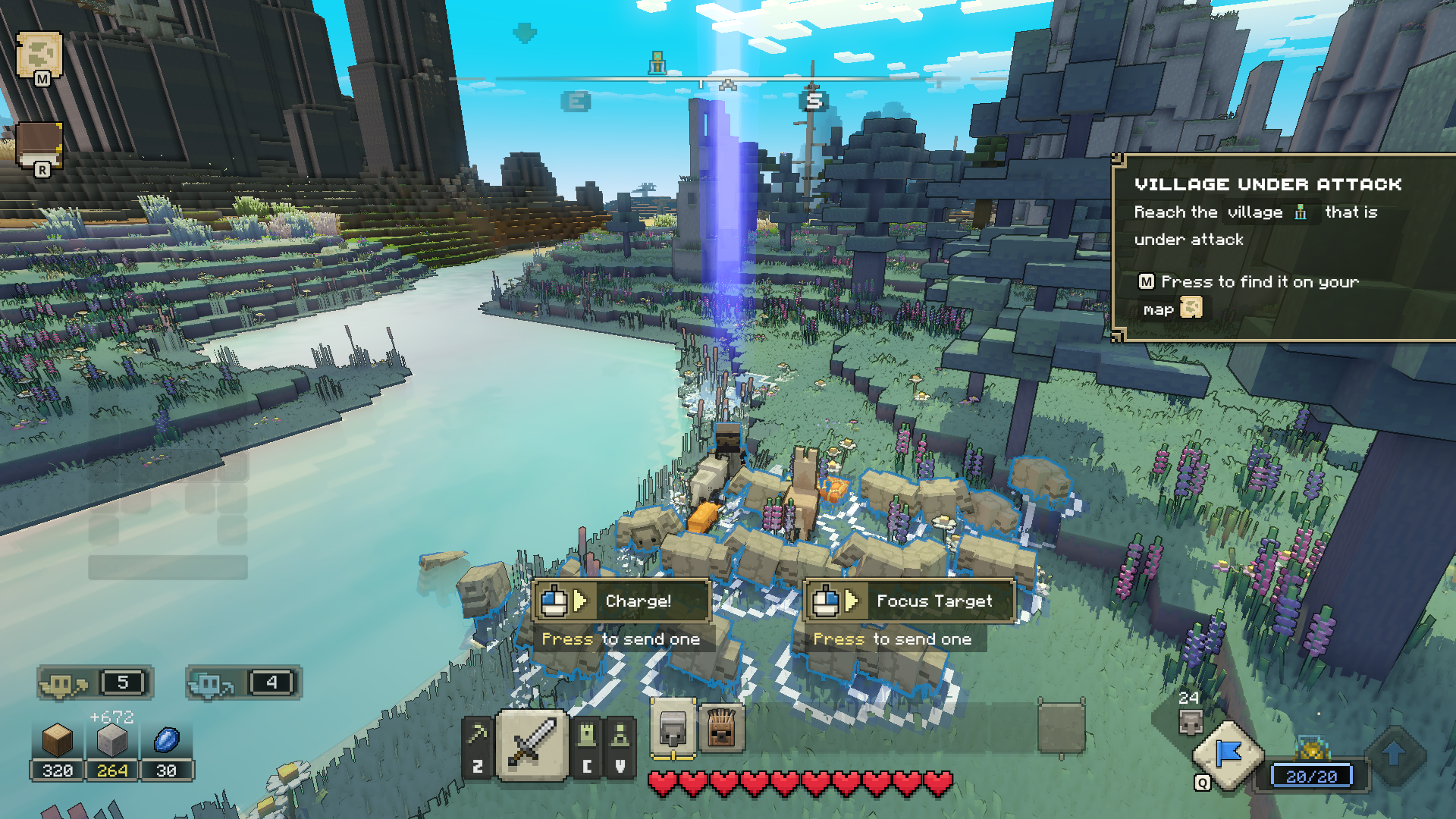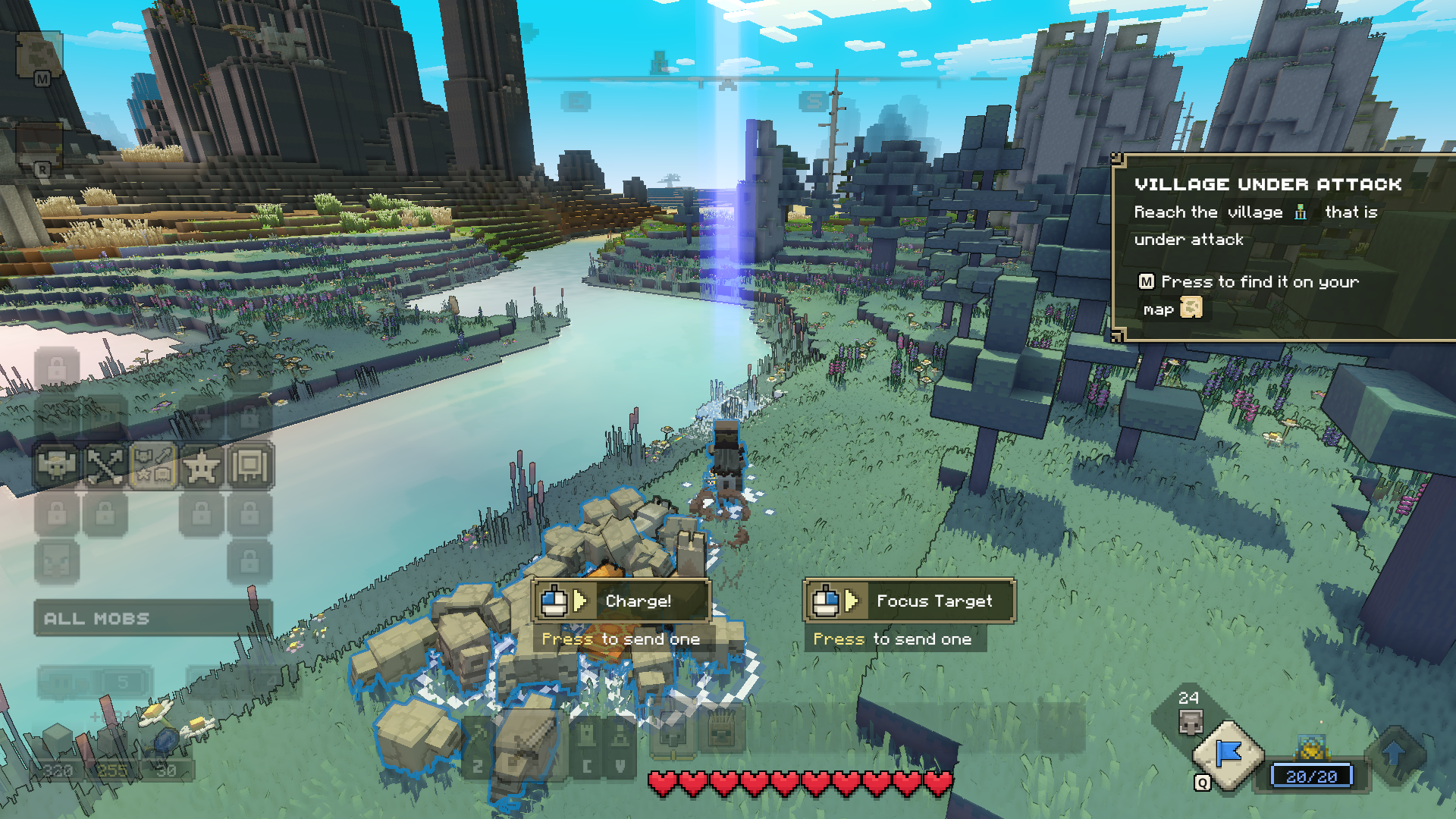Stay updated with the latest in the gaming world through Too Much Gaming, featuring news, articles, game updates, videos, podcasts, and gaming advice for PS4, Xbox One, PC, and Nintendo Switch.

Minecraft Legends Review – Exploring Mobs and the Overworld

Minecraft is a widely recognized creative sandbox game that captivated audiences upon its launch in 2011. Since then, it has motivated countless players to craft their own unique adventures. Now, Mojang Studios is venturing into storytelling within the Minecraft universe, aiming to add a fresh perspective to their established world. One of their recent endeavors, Minecraft Legends, is an engaging strategy game that allows players to lead mobs in defense against a Piglin invasion. Although it may not revolutionize the genre, this spin-off has encouraged me to view Minecraft from a different angle.

Minecraft, but with a unique twist.
You assume the role of an ordinary Minecraft player within your own realm, constructing and crafting just like any other gamer. When a faction of Piglins launches an assault on the Overworld, enigmatic entities that govern the realm devise a strategy to summon you, the champion, to their domain. They provide you with the necessary resources to protect the Overworld from the Piglin onslaught and ultimately thwart their advance.
Minecraft offers a canvas for creating any world you can imagine, but until now, I never sensed a cohesive tone and character within the franchise. However, Minecraft Legends has changed that, appealing to audiences of all ages while maintaining the distinctive art style that defines the Minecraft brand. The game features the familiar pixelated, blocky aesthetics, but with improved visuals, including enhanced lighting and animations. This results in cartoonish facial expressions and a wealth of personality conveyed through gestures and sound effects.
As you advance in the game, you encounter a series of cutscenes that showcase the various clans within the Piglin invasion force, along with the leaders who oversee them. You’ll also be introduced to familiar Minecraft creatures, with whom you will form alliances to combat the Piglins. These scenes inject a significant amount of humor into the game, reminiscent of classic Looney Tunes, as you witness the leaders engaging with their followers in a playful, cartoonish manner, reminiscent of a nostalgic morning cartoon rerun.
The game emphasizes large-scale action, relegating building and resource collection to a secondary role and providing a more streamlined experience for both. In Minecraft Legends, the majority of gameplay involves leading a mob army to protect nearby villages or assault Piglin outposts, thereby reducing their influence in the region.
In the process of collecting resources, entities known as Alleys handle the tasks for you. All you have to do is guide them to a nearby resource. For instance, if you require wood, simply instruct an Alley to harvest from a nearby tree, and you will gradually accumulate that resource until it runs out. This streamlining of the gathering process allows you to concentrate on preparing for the upcoming battles in Minecraft Legends.

Initially, you can lead an army consisting of 20 units, but by the conclusion of the campaign, this number can exceed 80 simultaneously. During offensive operations, you primarily focus on dismantling Piglin strongholds by taking down their defensive towers and the structures that produce units for their defense, ultimately eliminating their presence in the region.
Commanding troops and guiding units is simplified into two main commands: rally, which assembles nearby units, and charge, which directs them to attack in the specified direction. Players can tailor these commands to specific types of units in the area. This system is primarily utilized to concentrate fire on a specific target. For instance, stone golems excel at demolishing structures, so it’s essential to ensure they are targeting buildings.
The ease of command issuance is logical, given that this strategy game is experienced from a third-person viewpoint. Your character acts as a rallying point for your allies, uniting them for a collective assault. Your role is not to achieve victory single-handedly; instead, you are tasked with coordinating the forces of the Overworld, empowering them to secure their own triumph. Although you are a hero, your offensive abilities are limited to wielding your sword, with little else to offer. Your real power is derived from the composition of your army and your strategic deployment of their strengths.
As you advance, you unlock various types of mobs, each with distinct abilities. Skeletons excel in long-range combat, while Creepers act as formidable forces, capable of demolishing gates and structures with their explosive traits. Additionally, Zombies boast impressive health, and unique golems possess special skills, like shields that deflect ranged attacks or the power to summon various golems instantly. Achieving victory in Minecraft Legends requires a well-balanced mob lineup, ensuring that when you unleash your army, they effortlessly overpower any foes in their path.
The overall mechanics of army management and progression in Minecraft Legends are relatively straightforward when compared to other strategy titles. Players shouldn’t anticipate a highly intricate system, as there are no options for upgrading buildings or enhancing specific unit types. For instance, the stone golem you start with will retain the same attributes as those you encounter in the game’s final battles. The sole upgrade mechanism in the game involves increasing your capacity, which includes the number of mobs you can summon, the amount of resources you can carry, the size of your army, and the number of mobs you can gather to your banner. You can even rally various mobs and wildlife found throughout the game world to join your fight.
This method benefits the game, as, while I typically enjoy deeper progression and customization in strategy titles, the uncomplicated design of Minecraft Legends allows it to appeal to a wider audience. I found the game enjoyable, even with its simplicity, though there were certain aspects that caused some frustration.

The landscape can be a soldier’s greatest adversary.
Once you have successfully cleared a sufficient number of outposts, you will compel the leader of each clan to reveal their presence. This will initiate a challenging assault on the boss’s stronghold, culminating in a confrontation between you, your forces, and the boss.
The boss battles aren’t particularly challenging, since a massive Piglin can easily be overpowered by a sizable force, provided you can evade its strong attacks. The true challenge comes from reaching the boss, as a significant portion of the effort is dedicated to guiding my troops to a specific location during the siege. Maneuvering through elevated landscapes is frustrating, as it feels like I’m constantly overseeing my army during these critical times, ensuring that everyone is present and not simply idling or straying off.
In one scenario, I encountered a boss whose outposts were strategically positioned on elevated terrain, necessitating the construction of bridges for my army and me to gradually ascend to the key structures and ultimately confront the boss. These outposts exposed some weaknesses in the game’s mob AI, as it became quite exasperating to see some of my allies getting lost in the landscape. As we climbed, one or two would occasionally fall off, which was frustrating, as my forces would be gradually diminished due to their failure to stick to the designated path or being accidentally knocked off by other allies in the challenging terrain. Such situations prompted me to bring the bulk of my army to the base, order them to charge, then return to collect the lost units before rejoining the fight to drop off the stragglers. This cycle became a repetitive process.
During these significant moments, I found myself not on the front lines for the majority of the time, as my assaults had minimal impact on larger foes, particularly the boss. Instead, I played the role of an ideal support, helping to stabilize the situation and providing reinforcements when our front lines were becoming weakened.

It’s solely focused on offense and defense, nothing more.
While you are actively engaging the Piglins, they also launch their own assaults, targeting nearby villages linked to you. It falls to you to establish defenses to thwart the Piglins from ravaging and claiming these areas. This aspect of the game resembles a tower defense strategy, allowing you to construct walls and defensive towers to safeguard the territory. Alternatively, you can opt to rely solely on your army for defense, which can be challenging, as the Piglins typically attack from multiple directions. This feature may be the least engaging part of Minecraft Legends, as the Piglin threat rarely poses a significant challenge. You are given plenty of time to prepare for an impending attack, which often makes it feel more like a minor inconvenience. If a village falls, reclaiming it is a straightforward task, resulting in minimal repercussions in this part of the game.
Beyond the battles of raiding and defending, the Overworld feels rather quiet. You can unlock specific special golems to enhance your army or unique towers to bolster your defenses, but aside from that, the campaign’s procedurally generated map mainly consists of outposts to conquer and villages to protect. The various biomes are inhabited by the typical wildlife found in Minecraft.

A multiplayer experience with great promise.
In addition to the main campaign, Minecraft Legends features two additional game modes: Lost Legends and Versus Mode, the latter of which offers a fresh experience every month. During my gameplay experience, I encountered The Portal Pile, a challenge where players must protect a village from 20 consecutive waves of Piglin assaults. Successfully completing this challenge grants a new hero skin, encouraging players to return each month for new content and the chance to earn rewards for their efforts.
Unfortunately, I haven’t had much opportunity to explore Versus Mode, as it was challenging to find others to play with during the early access phase. I managed to participate in just one match, but it was an enjoyable experience. I had a great time collaborating with teammates in a 4v4 format, focusing on defending our base while strategizing to take down the enemy’s. One drawback I observed was the inconsistency in match duration, which can either fly by or feel prolonged, depending on the players involved. It will be interesting to see how the multiplayer experience evolves once a larger player community is in place.
I plan to return to this review after I have more experience with the game’s Versus mode. This mode is quite straightforward when compared to modern multiplayer games, lacking features such as a leveling system, upgrade options, or a battle pass with cosmetic rewards. Instead, it offers a basic Versus experience for players looking to compete against each other on a randomly generated map.

Minecraft Legends offers an enjoyable strategic experience set in the Minecraft universe, and its mechanics are straightforward to understand. Players are likely to appreciate the main campaign, especially when teaming up with friends, although some may find its constraints and shallow progression disappointing. As the fourth spin-off in the series, this title leaves me eager for more similar experiences. While Minecraft emphasizes creativity, this game demonstrates that Mojang can enrich this world with engaging characters and captivating narratives that enhance the experience without compromising the franchise’s fundamental spirit.




